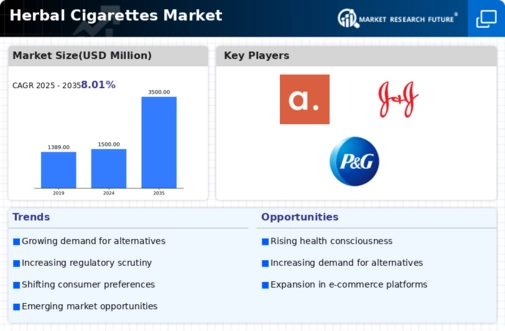Herbal Cigarettes Size
Herbal Cigarettes Market Growth Projections and Opportunities
The herbal cigarettes market is subject to various market factors that shape its supply, demand, and overall dynamics. One of the primary factors influencing this market is the growing consumer interest in healthier lifestyle choices. With increased awareness of the harmful effects of traditional tobacco cigarettes, many consumers are seeking alternative options such as herbal cigarettes. These products are often marketed as natural, nicotine-free, and free from additives, appealing to health-conscious individuals looking to reduce their exposure to harmful substances. The herbal cigarettes market is projected to reach significant growth with a compound annual growth rate (CAGR) of 5.90% between 2023 and 2032.
Government regulations and public health policies also play a significant role in shaping the herbal cigarettes market. While traditional tobacco products are heavily regulated and taxed, herbal cigarettes may fall into a regulatory gray area or face less stringent regulations. However, as awareness of herbal cigarettes grows and concerns about their potential health effects emerge, governments may introduce stricter regulations or taxation measures to ensure consumer safety and product quality standards.
Cultural and social factors also influence the herbal cigarettes market. In some cultures or communities, smoking is deeply ingrained in social customs and rituals. Herbal cigarettes offer a way for individuals to participate in these social activities without the risks associated with traditional tobacco smoking. Additionally, certain cultural beliefs or traditions may promote the use of specific herbs or botanicals for their perceived health benefits, further driving demand for herbal cigarettes.
Market demand for herbal cigarettes is also influenced by lifestyle trends and consumer preferences. As more people prioritize holistic health and wellness, there is a growing demand for natural and alternative remedies, including herbal smoking products. Additionally, factors such as flavor variety, packaging design, and marketing campaigns can influence consumer perceptions and purchasing decisions within the herbal cigarettes market.
Technological advancements and innovations in product formulation and manufacturing processes play a role in shaping the herbal cigarettes market. Manufacturers may develop new blends of herbs or utilize advanced extraction techniques to enhance the flavor and aroma of herbal cigarettes. Similarly, improvements in packaging materials and design can enhance product shelf appeal and differentiate brands in a competitive market landscape.
Economic factors such as disposable income levels, purchasing power, and price sensitivity also influence the herbal cigarettes market. While herbal cigarettes may be perceived as a premium product compared to traditional tobacco cigarettes, their pricing relative to other smoking alternatives can impact consumer affordability and market demand. Economic downturns or fluctuations in consumer spending habits may affect sales of herbal cigarettes, particularly among price-sensitive demographics.
Market competition is another factor shaping the herbal cigarettes market. As consumer interest in herbal smoking alternatives grows, more companies may enter the market, leading to increased competition for market share. Brand reputation, product quality, pricing strategies, and distribution channels all play a role in determining the success of herbal cigarette brands in a competitive market environment.
Consumer education and awareness about the potential benefits and risks of herbal cigarettes also influence market dynamics. Manufacturers and health advocates may engage in educational campaigns to inform consumers about the ingredients, manufacturing processes, and health implications of herbal smoking products. Similarly, media coverage and word-of-mouth recommendations can shape consumer perceptions and influence market trends within the herbal cigarettes industry.








Leave a Comment